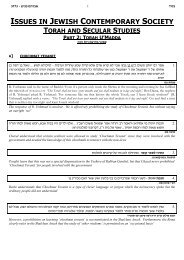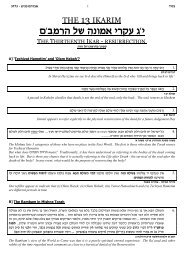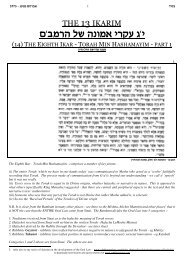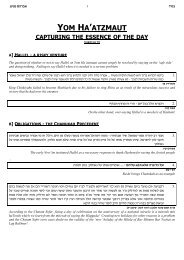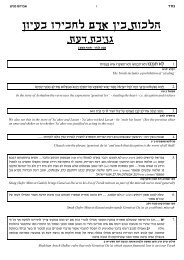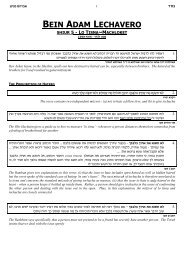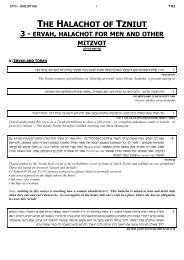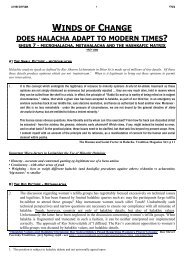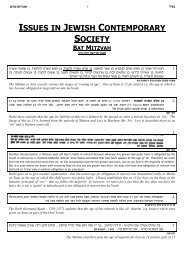Tzniut - MT Shiur 1 - Rabbi Anthony Manning
Tzniut - MT Shiur 1 - Rabbi Anthony Manning
Tzniut - MT Shiur 1 - Rabbi Anthony Manning
Create successful ePaper yourself
Turn your PDF publications into a flip-book with our unique Google optimized e-Paper software.
5773 - dbhbn ovrct<br />
1<br />
sxc<br />
THE HALACHOT OF TZNIUT<br />
1 - THE TORAH MITZVAH - SELF-RESPECT<br />
vkhv, ,arsn<br />
A] INTRODUCTION<br />
In any discussion of tzniut it is critical to distinguish between different areas of halacha. These exist as separate units but<br />
interface and intertwine with each other to create a complex halachic picture. In particular we will need to deal<br />
separately with:-<br />
1 - The general halachot of tzniut as self-respect. This apply equally to men and women and are not limited to (although<br />
include) issues of dress. They appear in Shulchan Aruch O.C. 1,2,3, 240 and Even Haezer 25.<br />
2 - The specific halachot of tzniut as they relate to dress. These focus on the concept of Dat Yehudit, as developed in the<br />
gemara in Ketubot. They apply in principle to men and women although are focused specifically on women in the context<br />
of the ketubah. They appear in Shulchan Aruch in Even Haezer 115.<br />
3 - The halachot concerning ‘ervah’ and saying berachot, learning, davening in the presence of ervah. These relate<br />
almost entirely to MEN. They include issues of kol ishah, ‘tefach’ and ‘shok’ and are developed in the gemara in<br />
Berachot 24a. They can be found in Shulchan Aruch in Orach Chaim 75. These halachot are NOT primarily focused<br />
on tzniut or how women should dress.<br />
4 - Halachot regarding appropriate sexual behavior including what should be looked at, listened to and thought about.<br />
These apply mostly to MEN although invoke other more basic issues of sexual conduct which apply to both genders.<br />
They appear in Shulchan Aruch Even Haezer 25.<br />
5 - Halachot of lifnei iver - ie causing others to sin. This is a general principle which applies far beyond tzniut or dress.<br />
It does however in this context also include an obligation on women to give thought to the effect that their behavior/dress<br />
has on men and to be sensitized to this fundamental bein adam lechavero issue. Lifnei Iver is brought in Shulchan Aruch<br />
in many contexts, although not specifically on the issue of dress.<br />
6 - Ahavat Reim. There is always a halachic imperative of Ahavat Reim - the obligation to show sensitivity to others in<br />
all dealings with them. This will apply equally to both men and women, although in different ways. Men must be<br />
sensitive so as not to offend women in the way that they discuss or encourage appropriate dress. Some women may be<br />
dressed appropriately for their dat yehudit and men who do not approve will have to look away and keep quiet. Women<br />
who are not dressed according to halachic requirements must, as in all halachic issues, be treated respectfully and with<br />
dignity as set out in the general halachot of tochacha. On the other hand women must be conscious of the need for<br />
sensitivity in dress and behavior when with others (both men and women) who may be offended by certain types of<br />
clothing. They will need to be tolerant of other people’s views, especially where they disagree with them<br />
B] THE TORAH SOURCE FOR TZNIUT<br />
Note: Everything in sections B and C applies equally to men and women<br />
, t ,h X f u T c J u Vc v T r<br />
p j u .Uj W T c J C vh v u Wbzt kg Wk vh v T s ,h u (sh) :.Uj v N J ,tmh u vbj Nk .Uj n Wk vh v T sh u (dh) 1.<br />
c J u rc S ,u rg W c v t rh t«k u J«us e Whbj n vh v u Whbpk Whch«t , ,k u Wkh M vk Wbj n cr<br />
e C QK v , n Whe«kt wv h F (uy) :W , tm<br />
Whrj t n<br />
uy-dh df ohrcs<br />
The Torah includes a mitzvah to keep the ‘battlefield bathroom’ clean and dignified. The involves a constant awareness<br />
that G-d’s existence and presence is real at all times and that, as such - J«us e Whbj n vh v u - our lives and surroundings<br />
must remain ‘kadosh’. Part of this includes not allowing any ‘ervah’ to be seen around us in such a way that expels and<br />
excludes kedusha and G-d’s presence
5773 - dbhbn ovrct<br />
2<br />
sxc<br />
Wh v«kt o g ,fk gb m v u s x j , cv t u yP J n ,«uGg o t h F W N n Jr«uS eu«eh v nU c«uY v n o s t Wk shD v 2.<br />
j:u vfhn<br />
The concept of tzniut is one of the three fundamental principles of Judaism, as outlined by Micha<br />
v n f j oh gUb m , t u i«uk e t«cHu i«usz tC 3.<br />
c:th hkan<br />
The other place in Tanach that ‘tzniut’ is mentioned is in Mishlei; those who are ‘tzanuah’ are associated with wisdom<br />
ihjhbn ohgubmvu ,hghcac ohrunt ohrcs vnc kthknd ic iugna icr rnt //// vnst ,uzzuec u,ut ihbhhmn hgcr orf [t] 4.<br />
uktv ,ugnv kg kkujn tvh vzn yekbv kf ohrnutu ,ugnv ,t<br />
t:v hba ragn vban<br />
The expression ‘ohgubmvw appears 3 times in the Mishna, twice in connection with sha’atnez and once here in relation to<br />
kerem reva’i - fruit from the fourth years’ crop which had to be eaten in Yerushalayim or redeemed on coins and the<br />
coins taken to Y-m. In the Shemitta year when such fruit was accessible to all comers the concern was that they would<br />
not realize that it had to be eaten in Y-m. Some people would put down a marker to inform the public. But the ‘tznuim’<br />
would lay out money to pre-redeem the fruit before others took it<br />
ihruxhtc ohesesnv ov ihgubma ubrthc rcfu 5.<br />
oa o"cnrv aurhp<br />
<strong>Tzniut</strong> in this context means awareness of mitzvot and a focus on avoiding issurim<br />
gubmv tkt gubm iht ohnfj urntu 'lhvkt og ,fk gbmvu (wu vfhn) ch,fu 'ause lhbjn vhvu (df ohrcs) ch,fs gubm ,uhvk 6.<br />
odu /caha sg vkdn ubhtu jpy uhrujtu ohhjpy uhbpk vkdn ouhc vbpb tuva lrsf vbph vkhkc vbpbvu 'txfv ,hcc<br />
/// ,umhrpc tku ,ughbmc ,uhvk lhrm rcs kfc od 'gubm ,uhvk lhrm vyhnv ahna,c<br />
zb vumn iye ,uumn rpx<br />
The Sefer Mitzvot Katan (written in 1277 by R’ Yitzchak of Corbeille, one of the Ba’alei haTosafot) learns that there is a<br />
Torah mitzvah of tzniut from ause lhbjn vhvu. His application of this mitzvah is in the most private places - using the<br />
bathroom and sexual intimacy. From these paradigm cases he learns out to all life situations<br />
//// vru,v ,cvtn ,uhrcv ehjrna hpk v,hn chhj ,ughbm unmgc dvub ubhta ofj shnk,u 7.<br />
c vvdv zb vumn .rp ubhcr ,uvdv 'iye ,uumn rpx<br />
Rabbeinu Peretz (a younger contemporary of the Smak) immediately relates this mitzvah to the behavior of a talmid<br />
chacham<br />
C] TZNIUT IN PRACTICE<br />
ostv ,chah iht hf 'ohvktv hbpk ohfkuv rat ohehsmv ,ukgncu vru,c kusd kkf tuv - (j:zy ohkhv,) shn, hsdbk wv h,hua 8.<br />
habt og tuvu ubumrf uhp ,cjrvu urucs tku 'kusd lkn hbpk tuvu uhexgu uh,ugub,u u,chahf 'u,hcc usck tuvu uhexgu uh,ugub,u<br />
uhkg snug 'usucf .rtv kf tkn rat 'v"cev kusdv lknva uck kt ostv ohahaf a"f /lknv caunc urucsf 'uhcureu u,hc<br />
vgbfvvu vtrhv uhkt ghdh shn '(sf 'df vhnrh) wv otb ubtrt tk hbtu ohr,xnc aht r,xh ot :rntba unf 'uhagnc vturu<br />
/// cfua tuv hn hbpk gsh ucfan kg ucfacu ,fk gbmvc od /// (c"b wp d"j ohfucb vrun) shn, ubnn u,aucu ,"hav sjpc<br />
t ;hgx t inhx recc ost ,dvbv ,ufkv ohhj jrut lurg ijkua<br />
The halacha of tzniut is recorded by the Rema in the first halacha of Shulchan Aruch as part of the principle of ‘sh’viti<br />
Hashem lenegdi tamid’ - to exist in a constant awareness of the reality of ‘ratzon Hashem’ even in the most private<br />
places<br />
txfv ,hcc gubm tvh<br />
d inhx recc ost ,dvbv ,ufkv ohhj jrut lurg ijkua<br />
9.
5773 - dbhbn ovrct<br />
3<br />
sxc<br />
t,hhruts vumnk ,ughbm vbun e"nxcu ,ughbmv ,shnc trndv dhkpns c"gu t"g cx ,ufrcc ihhg - gubm tvh 10.<br />
d inhx vfkv ruthc<br />
The Shulchan Aruch rules the obligation to be tzanuah is in the bathroom. The Biur Halacha brings the Smak<br />
ahna, ,gac stn gubm vhvhu 11.<br />
vf inhx ,uaht ,ufkv rzgv ict lurg ijkua<br />
The Shulchan Aruch also rules the obligation of tzniut in the marital bedroom<br />
'txfv ,hck vhsvc ,khhg ,t :injb cr uk rnt /vuv uh,ujrutc gubm htv :rnt 'injb crs vhne ,hjbs tbspx tuvv 12.<br />
/txfv ,hcc gubma hnk tkt - gubm ihrue iht :thb,s tk ht gubm ht ,gshu<br />
/cx ,ufrc<br />
Chazal stress that REAL tzniut is judged on who you are INTERNALLY and thus how you behave in a place where no one<br />
can see you. If a person dresses or behaves tzanuah in front of other people but acts like an animal when no one is there,<br />
he ultimately has no self-respect at all. Dressing a certain way is required in halacha but a person who does so may be<br />
playing a social game! <strong>Tzniut</strong> cuts through all that to a deep awareness of the realty of G-d<br />
:ovk vrnt - lfk ,hfza ,hag vn :ohnfj vk urnt /vkusd vbuvfc uana ikufu ,hjnek vk uhv ohbc vgca :ibcr ub, 13.<br />
ukhguv tku 'if uag vcrv :vk urnt - /hrga hgke h,hc ,urue utr tk hnhn<br />
/zn tnuh<br />
This is the famous account of Kimchit who had 7 sons who merited to serve as Cohen Gadol. She felt that her merit was<br />
due to the fact that her hair was never uncovered, even in the house. The <strong>Rabbi</strong>s responded that many other women had<br />
done this but it do not work for them. Why not Are the <strong>Rabbi</strong>’s rejecting Kimchit’s claim to merit<br />
heukj ,rnhtu hatr ,urga h,hc ,urue utr ot ///// 14.<br />
t"vq s ruy jk ;s t erp tnuh ,fxn hnkaurh sunk,<br />
The version of this conversation in the Talmud Yerushalmi adds another critical element. She responded that her hair<br />
was never uncovered and her clothing was never undignified even in her home. This is not a gemara about hair covering<br />
but about deep inner dignity. Other women who went through the same motions, but without the character development,<br />
did not succeed<br />
kt c /vxufn tuva ouehaf tmnbu 'cfua ubsugc uh,ugurzu (uatr) uc xhbfhu ueukj jeh tkt cauhn ueukj ackh tk t 15.<br />
(d:u vhgah) usucf .rtv kf tkn v"cev hf 'hbtur hn c ohrsj hrsjc hbbv :rnth<br />
c inhx recc ost ,dvbv ,ufkv ohhj jrut lurg ijkua<br />
The Shulchan Aruch rules that a person should get dressed under the covers so that he will not need to walk around the<br />
bedroom naked. Even if no one can see him the whole world is filled with G-d. Note that this does not mean that ‘G-d is<br />
looking’ but rather that a person should have an awareness of G-d’s reality at all times<br />
tkv ohrsj hrsjcu vkhk tuvaf ukhptu v"cev hbpk vaucu ,ughbmc dvb,vk lhrm ostvu upud vkd,h jrfvc zts - cauhn (t) 16.<br />
ukhptu uracn ,ukdkn jrfv ouenc tka vz ogy ,njn shn, rvzhk lhrm ifu /lrc,h uhbpk vrutfu vfhajfu usucf .rtv kf tkn<br />
oackk vtrh ,utkpbtv f"g /vzjv sg urtumu us"cue sg ush ,ukdk htar kct okugk ohsdcc vxufn ,uhvk ufrsa vn kf ygn<br />
tmuhf kf ifu .hec ukhpt ;jh ihfkuv ihta ukt ,ubhsnc okugk ,uxufn ,uhvk ifrsa uhkdr ,ukdk tka ihsxv ,j, f"d oyapk ut<br />
,umhrp ouan vzc iht rjt ihbgc t"tu ohnurg oa lkhk ost hbc ka ifrsa .jrnv ,hcc ifu rjt ihbgc rapt hta tk ot vzc<br />
lrumk tka ;udv hukhdc lkh tka hsfc rapta vn kf rvbk lunx auckku yuapk rvzh er if ihsv rvbc .juraf ifu<br />
t e"x c inhx vrurc vban<br />
The Mishna Berura applies this in his context to putting on socks under the covers. His reasoning is that NO ONE would<br />
walk around barefoot EVEN in the house. Since people would be deeply shocked in those places to know that you did so,<br />
thus walking around in that way is the issur of ‘hineni bechadrei chadarim’. You don’t care if you think no one knows!!<br />
Thus this halacha of self-dignity will apply in different ways to different people in different situations.



